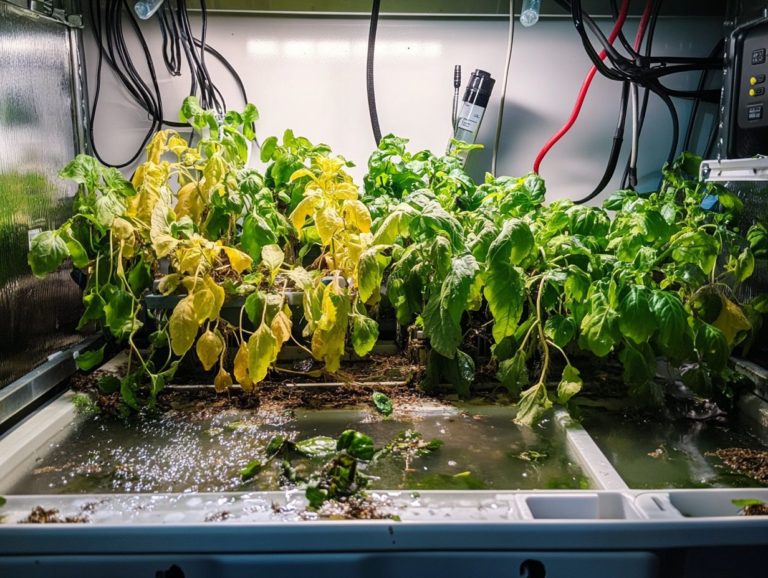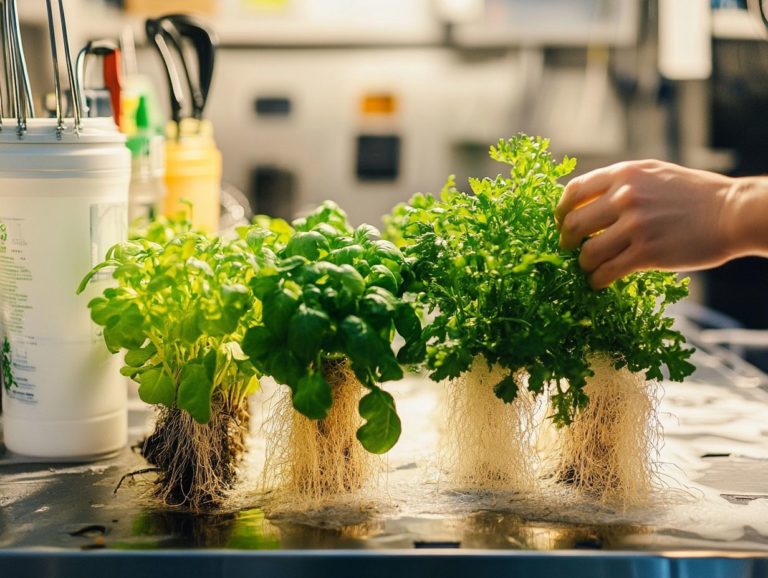Identifying and Treating Hydroponic Stress
Hydroponic gardening offers many advantages, but it also presents unique challenges, especially for plant health. Understanding hydroponic stress is vital for any grower aiming to keep plants thriving.
Let s explore what hydroponic stress means, its causes, and how to identify its signs. You ll also learn effective treatment strategies and preventive measures to maintain a healthy hydroponic system.
Join us as we guide you through the best practices to ensure your plants flourish beautifully.
Contents
- Key Takeaways:
- Understanding Hydroponic Stress
- Identifying Hydroponic Stress
- Treating Hydroponic Stress
- Effective Treatment Strategies
- Preventing Hydroponic Stress
- Frequently Asked Questions
- What is hydroponic stress and how can I identify it?
- How can I prevent hydroponic stress in my plants?
- What are some common causes of hydroponic stress?
- Can I treat hydroponic stress in my plants?
- Are there any natural remedies for hydroponic stress?
- Can hydroponic stress affect the quality of my plants?
Key Takeaways:

- Hydroponic stress is a plant’s response to unfavorable growing conditions, leading to stunted growth and lower yields.
- Signs include wilting, yellowing leaves, and root rot. Common triggers are nutrient imbalances, temperature changes, and pests.
- Prevent stress by maintaining optimal conditions, monitoring plant health regularly, and addressing issues quickly. Treatment includes adjusting nutrient levels, ensuring proper lighting and ventilation, and using organic pest control methods.
Understanding Hydroponic Stress
Hydroponic stress is crucial for anyone growing plants in hydroponic systems. It directly affects both plant health and yield.
This stress can come from several factors, like nutrient deficiencies, light intensity, and environmental conditions such as temperature and humidity.
Stressed plants may show symptoms that reduce their ability to convert sunlight into energy. Recognizing these signs early allows you to intervene and help your hydro garden thrive.
What is Hydroponic Stress?
Hydroponic stress is the strain that plants feel under less-than-ideal conditions in a hydroponic setup.
This stress can result from improper nutrient levels, pH imbalances, or insufficient light exposure. Symptoms like wilting leaves, stunted growth, or discoloration can signal distress.
For example, low nitrogen levels can cause older leaves to turn yellow, while magnesium deficiency may lead to yellowing between leaf veins.
These issues affect photosynthesis, causing plants to struggle in converting sunlight into energy, which ultimately hampers their growth.
Causes of Hydroponic Stress
Hydroponic stress can arise from various sources, including nutrient deficiencies, light stress, and environmental factors.
Deficiencies in nitrogen and iron particularly lead to stunted growth and yellowing leaves, which indicate distress. Managing light intensity is essential; too much light can cause light stress or bleaching, harming plant health.
Environmental extremes are also crucial. Heat stress may cause wilting, while low humidity can result in rapid moisture loss. Overfeeding can lead to toxicity, complicating growth conditions.
Transplant shock can further hinder plants’ ability to adjust, increasing overall stress in a hydroponic setup.
Have you experienced hydroponic stress in your garden? Share your thoughts or questions in the comments below!
Identifying Hydroponic Stress

Identifying hydroponic stress is crucial. Catching it early allows timely interventions to restore plant health and maximize yield.
Stressed plants exhibit signs like yellowing leaves, wilting, and stunted growth. These symptoms are influenced by factors such as light intensity and air pollutants.
Understanding the connection between these signs and how well plants make food is essential for maintaining a flourishing hydro garden.
Signs and Symptoms
The signs and symptoms of hydroponic stress can manifest in various ways, but you’ll likely notice common indicators like yellowing leaves, wilting, and nutrient burn.
Also, watch for light bleaching, which happens when leaves lose their vibrant color due to excess light. You might encounter root rot, characterized by a foul odor and darkened roots often due to overwatering or poor aeration.
If you see wilting seedlings, that could signal insufficient water or nutrient uptake. Nutrient deficiencies may appear as stunted growth or discolored leaves, while excessive nutrients can lead to nutrient burn, causing leaf tips to turn brown.
Understand these indicators to intervene promptly. This ensures optimal growth and the overall health of your hydroponic plants.
Common Triggers
Common triggers of hydroponic stress include inappropriate humidity levels, excessive or insufficient CO2 levels, and the unwelcome presence of pests or diseases.
These factors can dramatically affect your plants’ health and productivity. For instance, high humidity can lead to mold, while low humidity can stifle transpiration and hinder nutrient uptake.
Similarly, if CO2 levels are too low, photosynthesis may lag, or if they spike too high, your plants could experience stress.
Pests and diseases can complicate matters by attacking plant tissues or introducing harmful pathogens. Manage these factors well to create a thriving hydroponic environment!
Treating Hydroponic Stress
Effectively managing hydroponic stress requires you to implement preventive measures and strategic treatment tailored to the unique needs of your plants.
Addressing nutrient deficiencies and optimizing air quality and humidity levels can significantly boost how well plants make food an essential factor for plant recovery and growth.
Preventive Measures

Preventive measures are essential for maintaining healthy plants in your hydroponic systems, significantly reducing the risk of hydroponic stress.
Establishing a routine that includes regular monitoring of nutrient levels helps tackle potential deficiencies before they escalate, ensuring your plants receive optimal nourishment.
Tread carefully when feeding; overfeeding can lead to toxicity and complications. Optimizing light intensity is vital; providing the right amount of light promotes vigorous growth while preventing insufficient photosynthesis.
Maintaining appropriate humidity levels is crucial. This promotes overall plant health and helps fend off diseases that thrive in overly moist conditions, cultivating a thriving ecosystem for your crops.
Effective Treatment Strategies
Effective treatment strategies for stressed plants often center on restoring balance in the hydroponic environment and enhancing photosynthesis efficiency.
Begin by adjusting your nutrient mix. Tailoring the composition and concentrations of essential minerals ensures your plants receive exactly what they need for optimal growth during their recovery.
Managing ethylene production is critical. You can easily reduce ethylene production by removing certain materials and improving airflow to mitigate its effects.
Implement proactive disease management strategies. Conduct routine inspections and integrate beneficial microorganisms to prevent infections that could compromise plant health.
By employing these methods collectively, you will promote rapid recovery and enhance overall growth, paving the way for more resilient hydroponic systems.
Preventing Hydroponic Stress
Preventing hydroponic stress is essential for maintaining the health and productivity of your plants. Adhere to best practices in cultivation to create an optimal environment for growth and development.
Best Practices for Maintaining Healthy Plants
- Prioritize effective nutrient management by regularly checking and adjusting nutrient levels according to your plants’ specific needs.
- Monitor light intensity using light meters to determine the right amount of light, preventing both underexposure and potential scorching.
- Adjust humidity levels to ideally between 40-70%. Small fans can enhance air circulation, reducing mold risk while promoting efficient transpiration.
Integrate these strategies into your regular care routines to foster optimal growth and cultivate a flourishing hydroponic environment.
Frequently Asked Questions

What is hydroponic stress and how can I identify it?
Hydroponic stress occurs when plants in a hydroponic system experience unfavorable conditions, such as improper nutrient or pH levels. Signs can include stunted growth, yellowing or wilting leaves, and poor root development.
How can I prevent hydroponic stress in my plants?
To prevent hydroponic stress, regularly monitor and maintain proper nutrient and pH levels, as well as environmental factors like temperature and humidity. Ensure adequate light and oxygen for the roots.
What are some common causes of hydroponic stress?
Common causes of hydroponic stress include nutrient imbalances, incorrect pH levels, inadequate lighting, poor temperature and humidity control, and root diseases or pests. Identify and address these issues promptly to prevent stress.
Can I treat hydroponic stress in my plants?
Yes! Treat hydroponic stress by adjusting nutrient and pH levels, increasing light and oxygen to the roots, and addressing root diseases or pest infestations. Regular monitoring of growing conditions is crucial.
Are there any natural remedies for hydroponic stress?
Yes, use organic fertilizers like seaweed or fish emulsion to provide essential nutrients. Introducing beneficial microbes and fungi to the root system can also improve plant health and resilience against stress.
Can hydroponic stress affect the quality of my plants?
Yes, if untreated, hydroponic stress can lead to reduced growth, diminished yields, and lower quality produce. Closely monitor and promptly address signs of stress to ensure your plants reach their full potential.
Act now! Start implementing these strategies to ensure your hydroponic plants thrive and produce high-quality crops!






